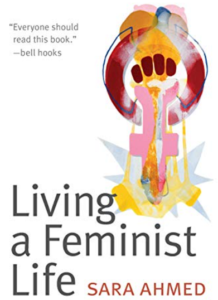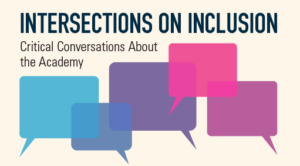This page has been developed in conjunction with Dr Vânia Gala from the CPP department.
What is Critical Citation Practice?

Critical citation practice is about joining the dots regarding who you are citing and why, and who you are not citing. Citations have the power to shape disciplines and canons by including or excluding certain scholarship. By looking at who you are citing, you can explore the exclusionary history of these fields and perhaps find under represented scholars/practitioners to cite which will help to increase their visibility. Citation is important as it builds a structure of knowledge and experience, but current citation methods embody the current structures of privilege – white, cis-male from elite academic institutions.
There are existing resources about critical citation practices that can help you think what it means to cite your sources in a more critical way:
Sara Ahmed – feminist critical approach
You can read about Sara Ahmed’s citation practices in their blog feministkilljoys especially in the post Making Feminist Points. They talk about who appears and who does not appear in papers/presentations and how this must be challenged.
In Ahmed’s book Living a Feminist Life they explain their practice to not cite any white males which has led them to explore other work that has been left behind or cast aside.
 Ramia Mazé in Bauhaus Futures talks about how Sarah Ahmed influenced their citation practice. As part of their preparation process they list potential citations in a spreadsheet to help make more conscious choices. They describe their process of encountering different sources and how they contribute to expanding their knowledge (p.10 of chapter: Situating the Bauhaus in Design History).
Ramia Mazé in Bauhaus Futures talks about how Sarah Ahmed influenced their citation practice. As part of their preparation process they list potential citations in a spreadsheet to help make more conscious choices. They describe their process of encountering different sources and how they contribute to expanding their knowledge (p.10 of chapter: Situating the Bauhaus in Design History).

Beverly Weber talks about the politics of citation. They discuss how German feminism has historically ignored work by women of colour and how this needs to stop. They also comment:
“Acknowledging my place as a white woman is an important piece of this citational practice. For those of us who are white feminists seeking to produce anti-racist work and practice, it is also important to be cautious of the ever-present danger of appropriating the work of women of color. Citation itself is one guard against that, but not the only one. “
Consider establishing your own principles for citation in your research, and when you do cite sources from scholars who come from marginalised backgrounds, think and reflect on how you’re positioning their work within your field of study.
Citation Practices Challenge
This challenges you to reflect on the way you approach referencing the work of others in your own writing, presenting and thinking. There is also a Tumblr with resources to help you think about good citation practice. The main website can be found here.
One thing they suggest is to think about specific scholars or areas within your discipline you want to be more intentional about citing, or who you intentionally want to stay away from.
Cite Black Women Collective
This collective is a public campaign to encourage more people to #CiteBlackWomen. On social media they ask people to post quotes from black women’s work including poetry, music and academic articles. You can find more about this on their website.
They suggest everyone should read more work by black women and credit them in your own work.
Victor Ray in the article The Racial Politics of Citation argues that by continually citing the same material then we are reinforcing the barriers to racial inclusion. They influence and shape what we are able to think about a field and lack of diverse citations can exclude writers from opportunities. It can “inform the types of research that is considered valid and worthy of citation”.
Utah State University Libraries Citation as a Critical Practice Discussion
This webinar explores the politics and ethics of citation. It includes a discussion of representation in disciplinary canons and the under citation of scholars who are Black, Indigenous, People of Color, LGBTQ+, and women. They consider citation in the context of power and privilege to try to understand what it means to adopt a critical approach to citation.
It is also accompanied by a download which includes resources recommended by the panel. Please note that not all are available via an RCS subscription.
Suggestions include:
– Explore the person you are citing – who are these people and why are we citing them? Would their own views lead to bias in their work?
– Consider specifically citing marginalised communities to help validate and legitimise what knowledge they are bringing to the topic
– Push back on only citing people with credentials as this is also privilege and not everyone who has the knowledge has the credentials
– Some of the main people in certain disciplines who are citied have negative backgrounds such as holding racist views – should we be citing these people? Or are we just re-enforcing white privilege? Perhaps contextualise them so still acknowledge, but critique their views and discuss what is wrong with them
– Find less cited material to diversify your bibliography
– Look at the people you are interested in reading and see who they are citing: this might help you find more diverse content
Citation Diversity Statements
This is a paragraph that is placed before the reference section of a piece of work and can be used to address the diversity of the references in terms of gender, race and ethnicity. It can discuss the percentages of diversity within the references, acknowledge the problem of citation bias, discuss methods used to identify material from writers of marginalised communities and highlight how this diversity has contributed to the paper’s originality or significance. These are currently being used in the sciences but might be something to consider.
Examples of a statement from a science paper:
(taken from Rowson, B., Duma, S.M., King, M.R. et al. Citation Diversity Statement in BMES Journals. Ann Biomed Eng 49, 947–949 (2021))
Abbreviated Statement
Citation Diversity Statement
Recent work in several fields of science has identified a bias in citation practices such that papers from women and other minority scholars are undercited relative to the number of papers in the field [blank]. We recognize this bias and have worked diligently to ensure that we are referencing appropriate papers with fair gender and racial author inclusion.
Full Statement
Citation Diversity Statement
Recent work in several fields of science has identified a bias in citation practices such that papers from women and other minority scholars are undercited relative to the number of papers in the field [blank]. Here, we sought to proactively consider choosing references that reflect the diversity of the field in thought, form of contribution, gender, race, ethnicity, and other factors. First, we obtained the predicted gender of the first and last author of each reference by using databases that store the probability of a first name being carried by a woman.9,18 By this measure (and excluding self-citations to the first and last authors of our current paper), our references contain 31% woman(first)/woman(last), 31% man/woman, 19% woman/man, and 19% man/man. This method is limited in that a) names, pronouns, and social media profiles used to construct the databases may not, in every case, be indicative of gender identity and b) it cannot account for intersex, non-binary, or transgender people. Second, we obtained predicted racial/ethnic category of the first and last author of each reference by databases that store the probability of a first and last name being carried by an author of color.1,16 By this measure (and excluding self-citations), our references contain 2% author of color (first)/author of color(last), 9% white author/author of color, 20% author of color/white author, and 69% white author/white author. This method is limited in that (a) names and Florida voter data used to make the predictions may not be indicative of racial/ethnic identity, and (b) it cannot account for Indigenous and mixed-race authors, or those who may face differential biases due to the ambiguous racialization or ethnicization of their names. We look forward to future work that could help us to better understand how to support equitable practices in science.




